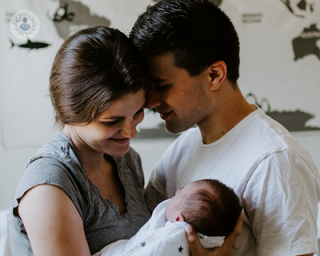Perineal wounds
Mr Nick Elkington - Obstetrics & gynaecology
Created on: 07-09-2021
Updated on: 01-18-2024
Edited by: Carlota Pano
What are perineal wounds?
A perineal wound is often sustained at childbirth. This may be in the form of a tear at the time of the delivery or a planned cut called an episiotomy. The perineal tear may involve the skin of the perineum and the lining of the vagina alone when it is superficial, but can extend to the muscles of the perineum and, at its worst, involve the muscles around the back passage which control the passage of wind and faeces.
The vast majority of perineal wounds which was repaired at the time of the birth, if repaired well and soon after childbirth, will heal without a problem. Perineal wounds, however, are prone to infection. This may be due to their proximity to the back passage which harbours bugs and also may be due to susceptibility of the mother from diabetes, infection of the womb during labour (chorioamnionitis), or due to blood clots in the wound. Perineal wounds which are infected often break down and the subsequent healing can lead to unsightly scars.

What are the symptoms of perineal wound infections?
It is important to recognise the infection at the initial stages.
The symptoms of an infection include:
- increasing pain in the wound
- swelling
- bad smell emanating from the wound
- a gap in the wound
- yellow discharge and yellowing of the edges of the wound
- fever when the infection is more severe
How are perineal wound infections treated?
Infection must be treated promptly with antibiotics.
After the course of antibiotics, the wound needs to be reviewed to ensure that the infection has resolved. If at this stage the gap in the wound is superficial and less than two centimetres, spontaneous closure of the wound with minimal scarring can be anticipated. However, if the gap is more than two centimetres, it is likely to heal with considerable scar tissue and leave a depressed wound.
In order to facilitate healing with minimal scarring, the wound may require refashioning to remove any dead tissue and to bring the edges together.
Some wounds, even after antibiotic treatment and refashioning, may break down again needing additional repair. Pre-existing conditions like diabetes, obesity, immunosuppressive conditions, and connective tissue disorders may lead to poor tissue healing. Doctors make a clinical assessment and decide the best management option after discussing with patients based on individual circumstances.
What happens if perineal wound infections are left untreated?
If left untreated, problems may arise, such as:
- The infection can cause pain, which may make it difficult for the mother to sit down and feed her baby.
- The infection can spread through the vagina and cause an infection of the womb.
- The wound can break down fully, leading to more scarring at the time of healing.
Do perineal wounds and infections take a long time to heal?
If an infection in the wound is not promptly treated, then extensive tissue damage can occur, leading to a complete wound breakdown. In this situation, unless the infection is treated aggressively and the wound refashioned after the infection has settled, healing will take a long time as scar tissue begins to bridge the gap in the wound from its depths.
What can be done to assist the healing process?
After a perineal wound has been stitched, it is important to:
1. Keep the wound clean: Your midwife may have explained this to you. You must clean the wound every time you open your bowel and pass urine. You must change your sanitary towel regularly, especially when you are passing bright red blood. The wound must be washed at least once a day with whatever you use to wash the rest of your body. During the rest of the day, washing with lukewarm water alone in sufficient. You can use the head of a shower to wash the wound or a jug. It is best to dab the wound dry rather than rub it. Sitting in a warm bath after 72 hours of the stitching of the wound may help to soothe the wound.
2. Take simple painkillers if needed: You may need paracetamol and ibuprofen for the first week, provided you are not allergic to this. Ibuprofen helps with pain from the inflammation and paracetamol is a good first line painkiller.
3. Use cold compresses: Cold compresses help with pain relief. It is best not to apply an ice pack directly to avoid frost burn. Using clean pads which have been placed in the refrigerator may help with this.
4. Use laxatives: You must use laxatives at least in the week after delivery to avoid constipation. Constipation is not uncommon after delivery and can cause one to strain. This can cause stiches to give away and must be avoided.
5. Practise pelvic floor exercises: Resuming pelvic floor exercises as soon as it is feasible will not only strengthen the pelvic floor and restore its health, but will also improve blood supply to the wound and help with healing
6. Prevent infections: Avoid coming into contact with young children with respiratory infections. This is often caused by a bug called Group A streptococcus. This bug can infect the episiotomy if your contaminated hand comes in contact with the wound or the contaminated toilet seat comes in contact with the wound. This bug can cause severe life-threatening infection in the mother, even if there is no perineal wound. Hence, hand hygiene is important to maintain. Cleaning the toilet seat regularly is also a useful measure.


